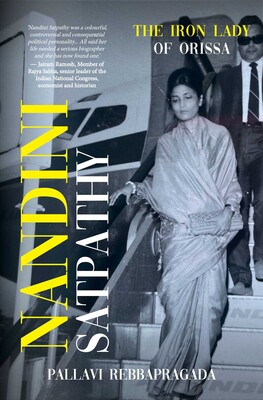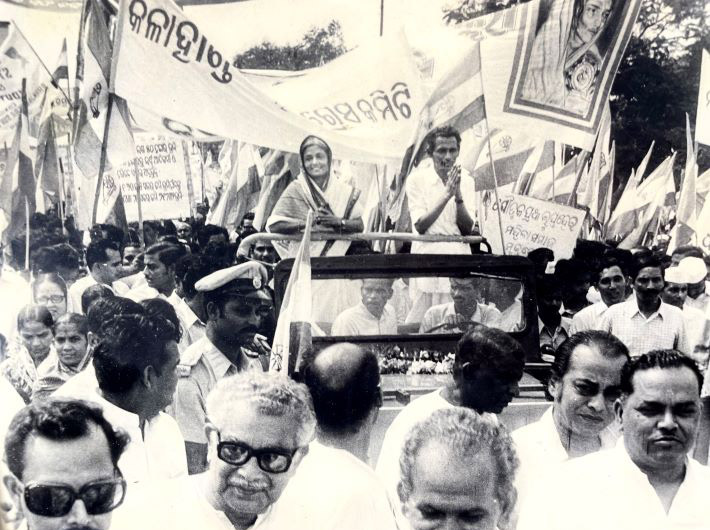An excerpt from a new biography of a one-of-her-kind politician by Pallavi Rebbapragada
Nandini Satpathy: The Iron Lady of Orissa
By Pallavi Rebbapragada
Simon and Schuster India, 321 pages, Rs 765
 It’s a name the new generation is not likely to be familiar with but should be. Nandini Satpathy, Odisha’s first woman chief minister, became a Rajya Sabha member at the age of 31 and held the portfolio of information and broadcasting in Indira Gandhi’s first government.
It’s a name the new generation is not likely to be familiar with but should be. Nandini Satpathy, Odisha’s first woman chief minister, became a Rajya Sabha member at the age of 31 and held the portfolio of information and broadcasting in Indira Gandhi’s first government.
Born to a family of revolutionaries and intellectuals, Satpathy had been jailed for pulling down the Union Jack from atop the edifice of Ravenshaw College in the 1940s. She was a teenager then, but thus began the makings of a force to be reckoned with.
During her chief-ministerial tenure, she implemented radical land reforms and tore down the tobacco trade mafia. Her political career was as tumultuous as was her friendship with Indira Gandhi. They were a close-knit duo, brought together by circumstances and kept together by a strong sense of affection and loyalty. That was until the Emergency. Once protected by her friendship with the prime minister, she was now subjected to brutal vendetta.
Pallavi Rebbapragada, a Delhi-based journalist and public policy consultant, tells the story of Nandini Satpathy in a new biography being published on April 26.
Here is an excerpt from the book, narrating a particularly dramatic episode in Satpathy’s political career.
Subordination to Indira’s Friend Unacceptable to State Congress
Nandini became Chief Minister of Orissa in 1972. Though relatively a nobody in the Orissa Congress unit, she had returned from Delhi after having served as a member of the Rajya Sabha and as I&B Minister of State in Indira Gandhi’s cabinet. The state cadre, which comprised of men, mostly much older to Nandini, did not accept her leadership right away for two reasons. One, that she was a woman. Two, that she was close to Indira Gandhi and that would effectively mean that everybody else’s hopes for a shot at power stood suspended.
The road from Cuttack’s Pithapur to North Avenue was neither too long, nor a very short one. This journey that the 31-year-old undertook in her childhood didn’t have these goals charted out because with time, politics and its purpose had acquired new meanings. She had walked barefoot for miles to reach protests sites as a teenager, had taught communism to students while she was still studying, and had spent dark nights in prison cells because she refused to accept British rule. The police baton had cracked her skull when she was expecting her first child.
‘The news of maa’s admission into the Rajya Sabha had spread through the neighbourhood. Those were the days when people didn’t reward accolades to women achievers, they doubted their womanhood instead. We watched maa get into a white ambassador. She waved at us. As she moved away, surrounded by police personnel, people huddled around our neighbourhood,’ narrated Nachiketa Satpathy, who was then all of 10.
He shared that those people peeping from their balconies had pointed to the car and said things like, ‘Once this car crosses the final bend of the road and becomes invisible, the woman inside will never return to this small town.’ Someone had also said *‘E gaadi gaula, aao asi bani,’* meaning this car that is leaving is not going to come back. The woman they were talking about was his mother. His younger brother Tathagata, who later went on to become a member of the 12th, 14th, 15th and 16th Lok Sabha from Dhenkanal, was then only five years old and blissfully unaware of where his mother was headed that day.
After Banamali Pattnaik resigned as the head of the Pradesh Congress Committee in 1961, Biju Pattnaik was elected to this post. In 1957, with the help of independents, Harekrushna Mahatab formed the government. In 1959, a new government of alliances with opposition leaders was formed. Mahatab reportedly expressed disinterest in including Biju Patnaik and Biren Mitra in his cabinet. Both were strong leaders with followers within the party. Mahatab had upset the apple cart. Owing to tensions within the party, he failed to present the state budget and resigned from chief-ministership in February 1961. Four months later, President’s Rule was imposed in Orissa. Mid-term elections were held in 1961 in which the Congress party came to power with a thumping majority and Biju Patnaik became the new Chief Minister. Through her unique style of electioneering and footwork, Nandini Satpathy had aided Biju Patnaik’s victory.
As he was preparing to form the government, Nandini along with her husband and her two sons, met with a road accident on their way to the Jagannath Temple in Puri. Locals noticed a jeep that had rammed into a tree by the roadside. They pulled out the family from underneath and rushed them to Sakhigopal Hospital nearby. The medical officer Somnath Mohapatra was related to Radhanath Rath, editor of the Oriya daily Samaj. He recognised Nandini and the news reached Biju Patnaik through the press circle.
During the six-month-long treatment at the hospital, Nandini’s hair had gone grey. Biju Patnaik would visit her often and kept track of the progress she was making. Inside one of the rooms at the Sakhigopal Hospital, where Nandini lay on a metal bed around syringes, silver strips of pills, shrouded by the scent of phenol, Biju Patnaik had shared with her that she was going to be nominated to the Rajya Sabha. On hearing this, Nandini had said that Rajya Sabha is for old people and that she would like to stay back in Orissa. Patnaik asked her what she would do here. Her reply charmed him. She had said, as her family recalls, ‘I will sit on the chair that you are sitting on.’ Two months later, she received a letter from the Secretariat. With an unhealed leg, she limped into an ambassador and left the friendly lanes of Pithapur behind to return in 1972 as her state’s Chief Minister.
Biswanath Das, the incumbent Chief Minister, had resigned from Chief Ministership of Orissa on 14 June 1972. The same day, Nandini Satpathy formed the government, which lasted until 3 March 1973. In a scenario of sudden change, MLAs defecting from the Congress Party is what had led to the fall of the government, leading to the imposition of President’s Rule on 3 March 1973. The build-up to the dissolution of the assembly in 1973 was tense. As the opposition saw it, the midterm election of 1974 was its chance to fight back and defeat the Indira Gandhi-Nandini Satpathy front.
At the time of assumption of office, she was not a member of the House so a by-election was organised in Cuttack through which she was subsequently elected.
After victory in the by-election, the Nandini Satpathy-led Congress formed the government on 6 March 1974.
[The excerpt reproduced with the permission of the publishers]
